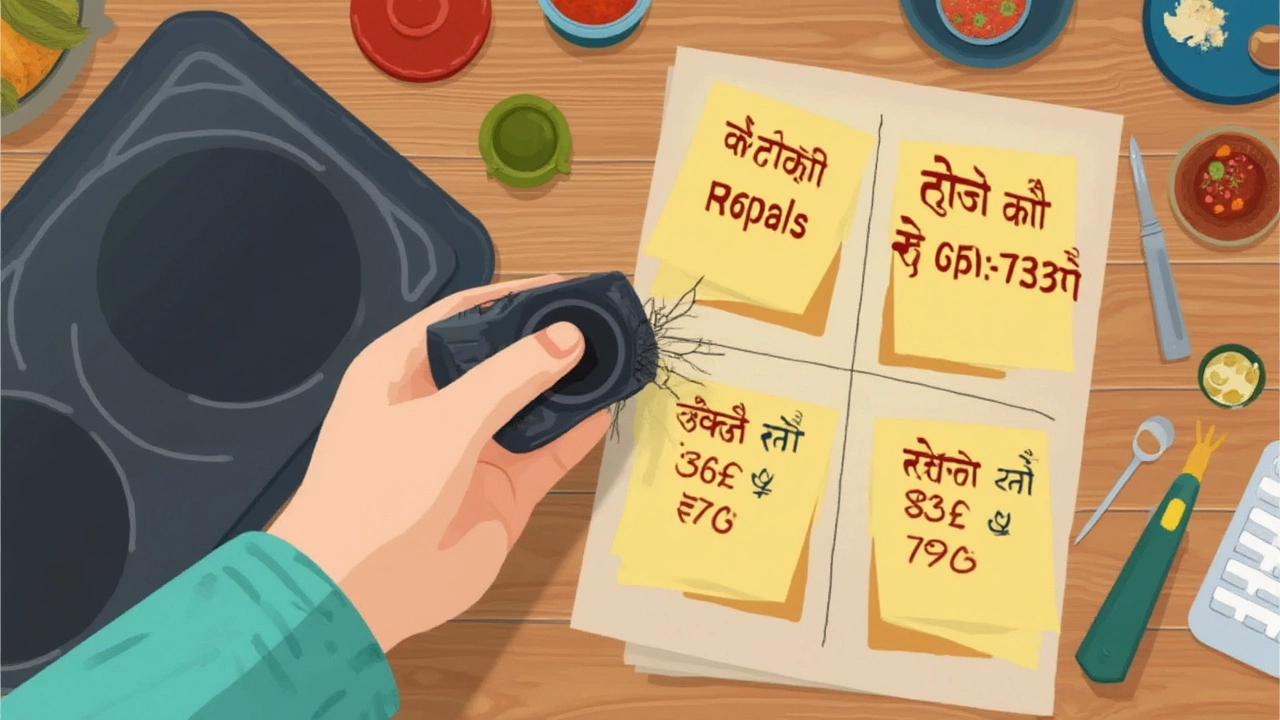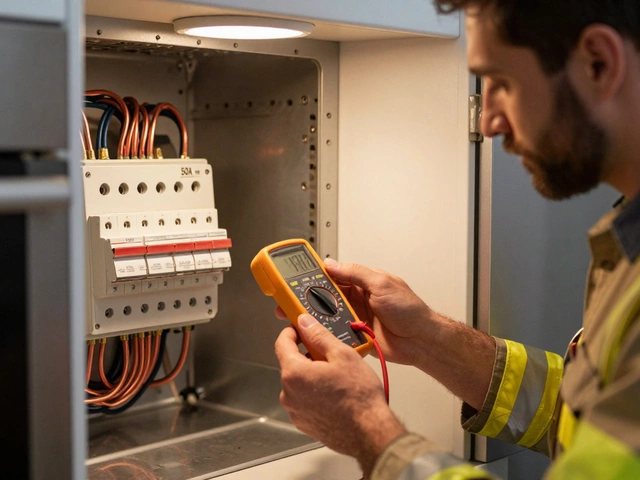Staring at a dead electric hob can make anyone panic, especially when you're mid-recipe and suddenly nothing heats up. Before you start Googling new appliances, fixing an electric hob might cost a lot less than you think.
If you call in a professional, the price depends on what exactly is wrong. Is it just a dodgy burner or is the whole touch panel frozen? Small fixes like a faulty switch usually land on the cheaper end, while bigger issues like a blown circuit board can bump up the bill.
Don't ignore the little stuff. Some issues, like a loose wire, are super inexpensive to sort out but can lead to pricier damage if you leave them. It’s always cheaper to solve a minor problem early than wait till it turns into a kitchen emergency.
- What's Wrong with Your Electric Hob?
- Typical Repair Costs in 2025
- Parts That Might Need Replacing
- Call-Out and Labor Fees Explained
- DIY Fixes vs Hiring a Professional
- How to Save Money on Hob Repairs
What's Wrong with Your Electric Hob?
Electric hobs can go on the blink for a bunch of reasons. Before you reach for your wallet, let's break down what might be going on. Sometimes, the issue is laughably simple—think tripped fuse, wonky power socket, or settings that accidentally got changed. Other times, it's a bit more technical and needs an expert eye.
- Electric hob repair is most often needed because of faulty heating elements. You'll notice one or more burners not heating up at all or only getting lukewarm, which usually screams 'element problem.'
- If none of the burners work, it's likely a bigger electrical issue, like a blown internal fuse or a dodgy connection in your home's wiring.
- Flashing error codes on touch-screen models point to problems with the control board or sensors. These faults need extra attention—sometimes you can just reset the unit, while other times replacement parts are a must.
- Strange clicking, buzzing, or burning smells? Don't mess around. Shut off the hob, unplug it if you can, and call for help. This usually means something is overheating or shorting out.
Here's a quick cheat sheet of common electric hob problems and what you might be looking at:
| Problem | Possible Cause | Usual Fix |
|---|---|---|
| One zone not heating | Broken element | Replace element |
| All zones dead | Power issue, tripped fuse | Check fuse, power supply |
| Controls not responding | Faulty touch panel or wiring | Repair/replace panel or check for loose wires |
| Hob keeps switching off | Overheating, fan problem | Check cooling fan, clean vents |
| Strange smell or sound | Electrical fault | Power off, call a pro |
It's always smart to double-check the manual for model-specific quirks. Some brands are notorious for glitchy sensors or fussy controls. If you're not sure, jot down any error messages or symptoms before ringing a repair service. This speeds everything up and can help you dodge unnecessary costs.
Typical Repair Costs in 2025
The big question everyone has is, “How much will it set me back if my electric hob stops working in 2025?” Prices range a bit, but you can usually expect most repairs to fall somewhere between £70 and £250. The cost depends on what part needs fixing and how much time it takes. If you’re dealing with a single broken heating element, it tends to be cheaper than replacing a whole control board.
For most jobs, repair companies charge a flat call-out fee, which covers the first hour of labor and the time to diagnose what’s wrong. In the UK, that call-out fee is usually £45–£80. After that, extra labor might be about £40–£60 per additional hour. Small parts, like switches or knobs, often cost £10–£30 each. Bigger fixes, like a new circuit board, can shoot up to £90–£180 just for the part itself.
Here’s a quick breakdown to give you a better idea of what you’re up against:
| Repair Type | Average Cost (2025) |
|---|---|
| Replacing a single hob element | £80–£120 |
| New control switch | £70–£110 |
| Circuit board replacement | £160–£250 |
| General diagnosis and minor fix | £70–£90 |
| Full hob replacement | £250–£500+ |
Some national chains might quote a bit higher, especially for premium brands. Local independent technicians often come in slightly cheaper. Just make sure you’re actually getting a electric hob repair pro, not someone winging it. Bigger city areas like London, Manchester, and Edinburgh can see prices at the top end of the scale. If you live in a rural spot, travel fees might get tacked on, so always ask up front.
If your hob is still under manufacturer warranty, you might get away with just a small call-out charge. Some retailers even offer flat-rate packages where one price covers parts and labor for pretty much any repair — usually £120–£180 for typical electric hobs. That can be worth it for peace of mind.
Parts That Might Need Replacing
When your electric hob acts up, the problem usually boils down to one or two bits inside that have either worn out or just decided to quit. Knowing which parts most often give trouble can help you understand where your money will go.
Here’s a breakdown of the most common culprits:
- Heating Elements: Easily the most swapped part. If a ring isn’t heating up or is only half-hot, it probably needs replacing. These elements usually last around 5 to 10 years if you use your hob regularly.
- Temperature Switches: When your hob won’t respond properly to what you set, the switch might be knackered. Swapping this is pretty standard in the world of electric hob repair.
- Control Knobs or Touch Pads: Physical or digital, controls can wear down—spills, bumps, and constant use do a number on them. Good news? They’re usually not too expensive to fix or replace.
- Thermal Fuse or Cut-Out: This is a safety bit that blows if something overheats. If your hob just won’t switch on at all, the thermal fuse could be the issue.
- Main Circuit Board (PCB): If nothing works—lights, controls, heat—then the main circuit board might be toast. This repair costs more and sometimes it’s at this point people think about a new hob.
Here’s a quick look at what these parts could cost in the UK (2025 average):
| Part | Typical Cost (£) |
|---|---|
| Heating Element | 35 - 90 |
| Temperature Switch | 20 - 45 |
| Control Knobs/Touch Pads | 7 - 40 |
| Thermal Fuse | 12 - 30 |
| Main Circuit Board (PCB) | 75 - 180 |
Prices can swing depending on your hob’s brand and model. Some older or fancy models have pricier parts. If you’re not sure what’s broken, call a pro—their diagnosis can save you from swapping the wrong bit and wasting cash.

Call-Out and Labor Fees Explained
This is the part a lot of people groan about—the cost just for someone to show up at your door. Most repair services charge a call-out fee. This covers the tech’s time and fuel. Not all jobs are equal, so let’s get into it.
Typical call-out fees in 2025 hover between £50 and £80, depending on your area. That’s just for having someone diagnose the issue, not counting actual repairs. If you’re outside a big city, expect the higher end, while metropolitan spots can be a bit cheaper thanks to competition.
Now, for the labor. This is usually charged by the hour, and you’re looking at rates from £35 to £60 per hour. Straightforward jobs sometimes fall under a flat fee, but anything tricky—think rewiring or control panel swaps—will rack up time, so more cash.
Here’s a breakdown to help you get a grip on those numbers:
| Type of Fee | Typical Cost Range |
|---|---|
| Call-Out Fee | £50 - £80 |
| Hourly Labor | £35 - £60 |
| Flat Rate Simple Fix | £60 - £100 |
| Control Board Replacement | £120 - £200 (including labor) |
One thing to watch for: Some services apply the call-out fee toward the final bill if you go ahead with the repair. Others tack it on separately. Always double-check this before booking—it can make a difference, especially if the job’s a quick one. The electric hob repair business is pretty competitive, so don’t be shy about asking if they price-match other quotes in your area.
- Ask for a clear quote up front. You want zero surprises.
- If your hob is old or high-end, check if the repair will be charged at a specialty rate.
- Weekend or emergency call-outs can cost double, so if it’s not urgent, wait for normal hours.
Bottom line: Knowing the difference between flat fees, labor rates, and sneaky extras saves you cash and stress when that hob gives up mid-cooking.
DIY Fixes vs Hiring a Professional
So, do you grab your screwdriver, or do you call in the pros for electric hob repair? The answer isn’t always obvious. It depends on how confident you are with tools—and how much risk you’re willing to take. Some fixes are safer than others, especially when electricity is in play.
If your hob won't heat up, start simple. Double-check that it’s plugged in and your circuit breaker hasn’t tripped. You’d be surprised how often people overlook this. If all’s good there, try these DIY steps:
- Clean the hob and control knobs—grease build-up can mess with sensors and buttons.
- Check for loose or burned wires if you know how to turn off the power safely (always unplug first).
- Inspect the heating elements for obvious damage, burns, or cracks (for visible coil hobs).
Anything deeper—like replacing circuit boards or rewiring—should be left to someone trained. Electric hobs carry live current, and mistakes here can be dangerous. According to UK government stats, faulty appliances cause more than 2,700 fires a year. Not something you want to risk in your kitchen.
What about the money? Doing it yourself saves labour charges, which typically range from £50 to £90 per hour in 2025. Here’s a quick look at what you might save—or risk spending—by tackling or skipping each option:
| Repair Type | DIY Cost | Pro Cost (avg) |
|---|---|---|
| Replace knob | £10–£20 | £60–£100 |
| Fix loose wire | £0 (just your time) | £60–£120 |
| Replace heating element | £25–£50 | £100–£180 |
| Replace control board | Not recommended | £120–£250 |
If you read your manual, you’ll see most manufacturers actually warn you off DIY repairs for anything electrical inside the hob. Messing up the wiring or components can void your warranty and lead to bigger bills or even injury. There’s a solid reason repair shops exist.
Bottom line: If your fix involves basic cleaning, checking plugs, or swapping out easy-access knobs, give it a go. But for anything electrical or internal—especially if you’re dealing with glass-top or touchpad models—bring in someone with the right training. That bit of extra cost can save you a lot of hassle in the long run.
How to Save Money on Hob Repairs
Everyone wants to save cash when the electric hob acts up, but there’s a right (and wrong) way to cut costs. Start by checking if your hob is still under the manufacturer's warranty. If it is, repairs or even replacement could be totally free—no one wants to pay out-of-pocket for something that should be covered.
Next, take a few minutes to do some basic troubleshooting yourself. Look for obvious things: is the hob plugged in? Are the fuses blown or have you tripped the breaker? Sometimes, the fix really is that simple. Manufacturers often have free troubleshooting guides on their websites, too.
If the problem isn’t simple, call around. Prices for fixing an electric hob repair can vary a lot between service companies. Some charge a fixed fee; others might bill by the hour. Ask up front if there are hidden fees like minimum call-out costs or weekend surcharges. Don’t be afraid to get two or three quotes before settling on a repair service.
For parts, you might be able to save even more. If the technician says you need a new knob or heating element, ask for a specific part number. Sometimes you can find genuine or compatible parts online for less—just make sure you buy from a trusted site and that it matches your hob’s model exactly.
Want an extra tip? Team up with a neighbor or friend. Some repair pros offer a lower call-out fee if they can do several jobs in one visit in the same area. If you and your neighbor both need appliance repairs, book together and split the call-out cost.
- Check for warranties or consumer rights—these might save you the whole bill.
- Handle basic checks yourself to rule out easy fixes.
- Shop around for quotes, and don’t forget to read reviews.
- Ask your repair tech if bringing your own part is allowed for extra savings.
- Consider group repairs with neighbors for better call-out deals.
Simple moves like these could save you a surprising amount. Sometimes the smartest fix isn’t just about repairing the hob—it’s about repairing how you shop for the service.



